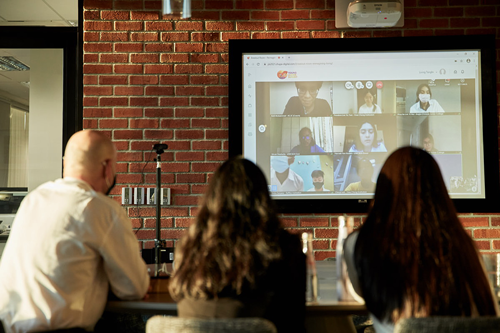
A methodology for solving society's most complex systemic challenges
The world’s most complex challenges can’t be solved through isolated actions. They require breakthroughs — moments when leaders see the system differently, connect across boundaries, and act together at scale.
Developed by the Bridge Institute over three decades of practice, it combines systems thinking and human transformation to unlock progress in some of the world’s most complex issues. It enables governments, businesses and communities to unlock progress where traditional approaches have stalled - by shifting not only what we do, but how we think, relate, and lead.




In this first stage, a small, diverse group of thinkers and actors examines the system as a whole - not the symptoms but the patterns underneath. They identify the points of leverage where small shifts could create lasting progress.

The second stage brings together the people who hold different parts of the problem: government, business, and civil society, to form a series of coalitions, one for each point of leverage. Each coalition member joins with shared intent. It’s a process of trust-building, not consensus. Courage replaces control; collaboration replaces hierarchy.

Breakthroughs happen when people see together what they could not see apart. These moments are designed: experiences that shift perspectives, commitments, and actions at scale. Breakthrough is a fusion of deep cultural and leadership change (‘changing hearts’) with brilliant intellect and novel innovation (‘changing thinking’).

Impact Teams and change-makers carry forward the new practices, policies, and relationships that sustain progress. It’s about learning, adapting, and building the capacity for systems to continue changing themselves.


Systemic change grows like a spiral — expanding from the few to the many. The Spiral Breakthrough operates at three intentional scales of influence, designed to turn insight into action and action into sustained impact.

A small, expert group that diagnoses root causes of the system and identifies leverage points

A curated, cross-sector coalition with expertise, influence, insight, ideas, and lived experience

A movement of community-based Changemakers who inspire, activate, and embed sustained change
The Spiral Breakthrough is designed for complex, systemic challenges.
Click each to learn more:
If a government department, corporation, or foundation could solve the challenge independently through traditional approaches, then you likely don't need this methodology. The Spiral Breakthrough is for challenges where multiple independent actors must come together in a broad-based multi-sector coalition – each holding a piece of the puzzle, but none holding the complete solution.
Example from practice: The Kalinga Fellowship in India brought together police, private sector, state government, non-governmental organisations, educational leaders, civil society representatives, and survivors themselves. No single group could have shaped – or even envisaged – the breakthrough alone.
You've seen it before: well-intentioned efforts that didn't create lasting change. Reports gathering dust, task forces that disbanded, initiatives that fizzled. This history signals that the problem is systemic, not technical – it won't be solved by doing the same things better or with more resources.
The Spiral Breakthrough is a proven tool for building momentum where progress has stalled. It's designed for intractable issues that traditional governance and policymaking have repeatedly failed to resolve, requiring radically different thinking and new approaches.
The issue crosses traditional boundaries. Government can set policy but needs business innovation and civil society insight to implement effectively. Business has resources and ideas but needs regulatory clarity and community trust. Civil society understands needs but lacks scale. Success requires governing in partnership – all three sectors working together in ways they haven't before.
Example from practice: The Afghan Refugee Coalition assembled employers (including Tesco), lawyers, refugees, and government to tackle employment barriers. Employers brought influence and practical pathways; lawyers provided expertise on legal status; refugees offered lived experience. This elegant fusion created solutions impossible within a single sector.
You're not looking for a pilot project or short-term intervention. You need deep, lasting change in how the system operates – changes that will continue long after the initial effort ends. This requires building capacity, shifting culture, and creating self-sustaining mechanisms across sectors.
If your goal is 3-5+ years out and requires fundamental shifts in how government, business, and civil society work together, The Spiral Breakthrough is appropriate. Citizens expect progress quickly, but the challenges are often long-term and systemic – requiring careful planning, trust-building, and sustained collaboration.
It's not enough to design the right policy, technology, or business model. People across sectors need to change how they think, relate, and act. Cultural norms, power dynamics, mixed trust levels among stakeholders, and conflicting motivations are as important as technical solutions. If you only address one side, the other will undermine progress.
Real challenge: Transforming healthcare from curative to preventative requires new delivery models (technical) AND fundamental shifts in how government departments work together, how businesses engage, and how communities take ownership of health (cultural). Both tracks must advance in parallel.
The challenge affects thousands or millions of people across sectors and communities. Getting it wrong has serious human, social, or environmental consequences. The stakes justify the investment of time, leadership attention, and resources required for systemic transformation through radical collaboration.
These are challenges that are vast, interconnected and emotionally charged – issues like addressing violence in society, catalysing economic growth, achieving climate goals, or building inclusive systems. They require engaging government, business, civil society, and the communities most impacted by the issues in co-creating solutions.


Learn how this methodology has transformed gender-based violence prevention in India, refugee integration in the UK, and healthcare in the Philippines.



